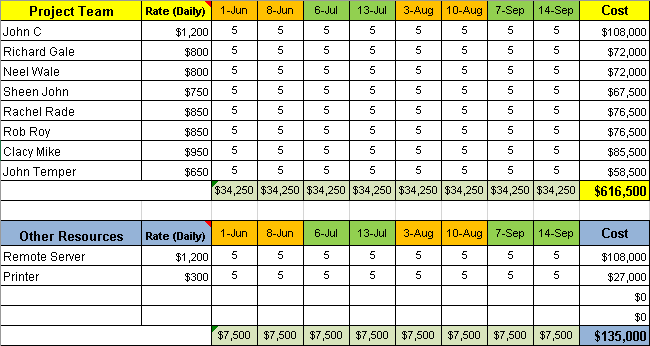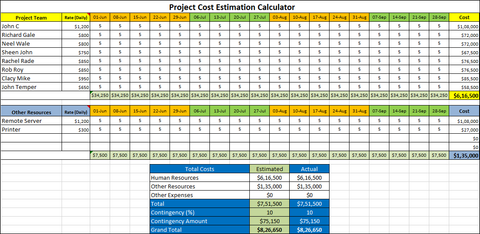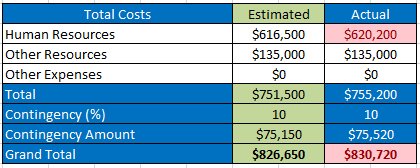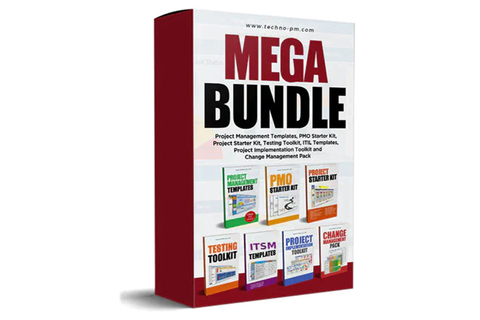Project Cost Management | Excel Templates
Cost Management
Project Cost and Management are key task for a project manager. In this article, we will look at how you can track resource costs, how you can estimate the project budget and write a cost management plan for your project.

Cost Tracking - Excel Template
Based on MS Excel so you will not need any other software. Both the budget estimation and tracking is done in the same spreadsheet. It has two sections - one for human resources or project team and one for other resources. Resources are allocated on a weekly basis. Resource rates can be set on a daily rate basis. Considers real-life situations like vacations and adding contingency. Highlights when the actual spend exceeds the estimated spend.
The excel template contains two sheets - Budget - Estimation, and Budget - Actual. The budget estimation sheet should be updated before the project starts and NOT changed once the project starts. After you are confident about the estimation you can update the Budget Actual sheet with the same numbers as an estimation. You also have the option to copy the estimates sheet and create an actual sheet but then the formulas and conditional formatting will not work.
The first section in each of the sheets is the Project Team Section. In this section, you need to have the name of resources and their daily rates. Then you have to enter their availability on a weekly basis. By default, everyone is considered to be working full time which is 5 days a week. If you have someone working for 50% time then you would enter 2.5 days or if someone is working for 80% then you would enter 4 days.

After the data is entered the sheet calculates the cost for each of the resources and then displays a total for each week as well as a grand total. The Other Resources Section is similar to the project team section but can be used to calculate costs for other resources required for the project. At the bottom of the sheet, there is a Totals Section which displays the key totals of the project which include - Human Resources Costs, Other Resources, Other Expenses and then other totals. There is an option to enter a Contingency.

Depending on the standards followed in your company you may select 10%, 20% or a different number. In case of the Actual sheet, there will be an additional column to the totals section which will indicate what the estimated value. The process of estimation and tracking is simple. During the estimation process always use the Budget Estimation Sheet. After the estimation is complete you should not make any changes to the estimation sheet.
As you progress with the project you should update the Budget Actual sheet with the actual time spent by the resources. In some cases, a resource might spent less time which will save money. But if the time spent is more then the project budget can go up. When updating the Actual sheet keep an eye on the Totals Section. So, if a team member takes leave for one day then the total days worked in that week will be four. If someone work for one day additional then the total days for that week will be 6.

- “Total Costs”: This sheet is the bottom line of the estimated budget, and presents the total costs of the other three sheets. It also includes the basic info of the project (Date of submission, planned start and end date of the project, PM’s name and the project’s name).
- “Labour Costs”: This sheet needs to outline all the costs of human effort which are associated with the projects’ scope. The tasks are broken down according to the WBS, thus ensuring that 100% of the effort is outlined. Then the teams are required to estimate the number of work hours that are needed in order to complete the task. Any other costs associated with employment, which vary according to the country the employee works in. Then the cost of the hour is multiplied by the estimated hours needed to complete the task, and the result is the cost of completing the task. The rows highlighted in green are the top tier activities of the WBS, and the total cost is derived of the aggregated total cost of the tasks under each one.
- “Materials Costs”: This sheet outlines all the costs of the resources needed for the project, which are usually tangible resources (Servers, equipment) but may include licenses of software. The number of servers is derived by the estimated number of end-users and required response time. The licenses needed are according to the employees. The office equipment depends on the number of employees and is derived according to past expenses, plus 5-10% to adjust for inflation.
- “Other Costs”: This sheet includes all the expenses which aren’t associated with the other two sheets. These are usually on-going expenses, which are needed for the “flow” of the project. The air expenses are derived from the estimated number of employees which will be required to conduct site/client visits. On top of that hotel and meal costs are added; according to the location (Sydney is more expensive than Bratislava).

The office space is calculated according to the number of employees when each employee requires X square meters for a work station. If many employees are planned to conduct site visits throughout the project’s timeline, then less office space is required. Refreshments and customer hospitality are derived according to the number of employees, planned customer visits and past costs of the same. The insurance costs are also derived from past costs, and these usually don’t change drastically.
Project Cost Management Plan Template
PCM (Project Cost Management) is a method used to measure the productivity and the cost of projects, throughout their full lifecycle. The goal of the method is to complete the project on budget. The main challenge is estimating the needed budget for the project, and this method aims at using historical data to estimate the needed budget. As the project progresses actual data is used to measure how close the estimation was, and to update it if needed.
Cost Estimate Table – In order to accurately estimate the needed budget, a table is used to break down the needed budget for all the required resources. Cost Change
Requests – As we all know all plans, projects’ scope, clients’ requests and standards change over the lifecycle. Budgets are no different, and the estimated required budget for one (or more) of the rows in the estimation table might need to be changed.

The process of requesting and approving a CR should include the following – The CR request is submitted in a standard form to the PM by the team lead. The PM analyzes the impact approving or denying the request will have on the project. The PM makes their recommendation to the client / main sponsor, who approves/denies the request. If the CR is approved: The estimation table needs to be updated.
Once the estimation is complete and the project starts rolling, the actual costs start to roll in in form of invoices. An invoice is a commercial document issued to the customer by the vendor, which relates to a sales transaction and usually indicates the agreed price, the number of products and quantities of goods/services. Each invoice needs to be allocated to one of the rows in the estimation table and aggregated with all other invoices. The aggregated actual cost is compared with the estimated one, while the overall completion of the row is taken into consideration.
Project Cost Estimation and Management Best Practices
- It is recommended to estimate the cost based on similar projects that were carried out in the company.
- The table can also be used to track the actual costs and the variance between the estimated and actual costs.
- The cost estimation table can also be used for CR’s (Change Requests).
- Each invoice needs one Point of Contact (POC) that can answer questions, etc.
- Each invoice needs a Purchase Order (PO) number, which means that this cost was approved by the customer and funded.
- All invoices related to a row in the estimation table need to be aggregated into one bottom line and compared to the estimated figure.
- Document: Save the initial project cost estimate (PCE), the changes which were made to it and their reasons and the actual estimate at the end of the project. Understanding which mistakes were made in the initial process will help bypass them in the next PCE put together.
- Communicate: Share the drafts of the PCE with the stakeholders, TL’s and choice
- employees. Their input can help with the accuracy of the final result and will raise their commitment to it.
- Drill down when using units: Use work hours as opposed to working weeks and square.
- meters of office space and not office floors.
- Don’t rush this stage of the project, thinking that extra budget will become available.
- down the road, if needed.
- Risks: Use a simple risk matrix while before putting together the PCE. They will help.
- with estimating the needed hours of risky tasks.
- Contingency: Always plan for unknowns. Usually, it is 10%-30% of the total budget,
- depending on the scope, innovation and the client.
Project Contingency And Its Importance
As with any uncertain endeavor, planning for the unknown will protect the project when the actual is different from the plan. As stated above, the percentage of the contingency is normally 10%-30% and is dependent on the following 3 factors –
- Scope: The larger the scope and longer the timeline, the higher the percentage should be.
- Innovation: If this is the first time that a project such as this is tried, the higher the contingency should be. This is the most important factor and should give the largest weight of all three factors.
- Client: The reputation of the client should also serve as a factor, and the more changes they requested in the past, the higher the contingency should be.




